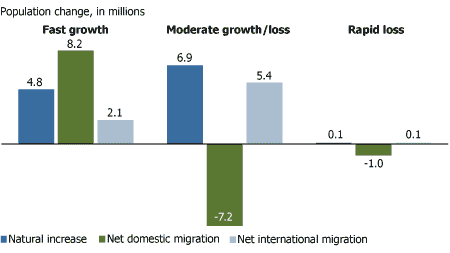Mark Mather
Associate Vice President, U.S. Programs

March 19, 2008
Associate Vice President, U.S. Programs
(March 2008) Despite rapid population growth in parts of the U.S. South and West, 43 percent of all counties lost population since 2000-nearly twice the number of counties that lost population during the 1990s (1,346 counties vs. 689 counties).
The data, based on the U.S. Census Bureau’s newly released 2007 Population Estimates, reveal a wide demographic divide between fast- and slow-growing areas. Fast-growth counties are most concentrated in the southern and western United States, especially in Florida, interior California, parts of Nevada, Arizona, Colorado, and Utah, and in the suburbs and exurbs of large metropolitan areas, such as Atlanta and Washington, D.C. The biggest population declines are in the rural Midwest, Upper Great Plains, and Mississippi Delta region, including New Orleans.
Although populations in New Orleans and surrounding parishes are still far below levels in 2000, people are starting to return to the area. In fact, St. Bernard Parish, along the Mississippi River, was the fastest-growing county in the country from 2006 to 2007 (a 43 percent increase).
Factors Behind Population Change in Growing and Shrinking Counties, 2000-2007

Source: U.S. Census Bureau Population Estimates.
Different factors drive population change in fast-, moderate-, and slow-growth counties (see figure). The primary source of population growth in fast-growing areas is domestic migration and natural increase (the excess of births over deaths). International migration plays a role but is dwarfed by migration from other parts of the country.1 In counties with moderate growth/loss, international migration—and the children of immigrants—help to keep the population afloat. This is especially true for the core counties of big cities such as Chicago, Dallas, Houston, Los Angeles, Miami, and New York. Domestic migrants continue to leave these areas while new immigrants come in to take their place. Finally, in areas that lost significant numbers of people, the minimal population gains through natural increase and international migration cannot offset the large outflow of domestic migrants seeking opportunities elsewhere.
For counties gaining population, the key policy issues are high housing costs, environmental damage, crowded schools, traffic congestion, and—in the case of immigrant magnets—adapting to new cultures and languages. Communities with declining populations face different concerns than those that are growing too fast. Instead of managing growth, they are managing the consequences of out-migration, including aging populations, job losses, declining tax revenues, and shrinking schools and neighborhoods. A key policy issue for areas with declining populations is how to attract and retain residents—and businesses—in their communities. Many rural communities, particularly in the Midwest, have been losing population for decades and are on the brink of extinction.
The Economic Research Service at the U.S. Department of Agriculture attributes population loss in rural areas to declines in farming and other rural industries, high poverty rates, lack of services, and—in some areas—a lack of natural amenities such as warm winters, forests, or lakes.2 The fact that most out-migrants are of reproductive age compounds the problem, because it means that fewer babies are being born to replace the aging population. Of the 1,346 counties that shrank in population between 2000 and 2007, 85 percent are located outside of metropolitan areas,3 and 59 percent rely heavily on farming, manufacturing, or mining.4
During the 1990s, rural areas benefited from steady growth in employment, income, and tax revenue, and the rural population rebounded.5 But just as the strong economy during the 1990s created new opportunities for people to live and work in rural areas, the weak economy since 2000 may be pushing people back to metropolitan areas to find jobs with decent wages.
Mark Mather is deputy director of domestic programs at the Population Reference Bureau.
